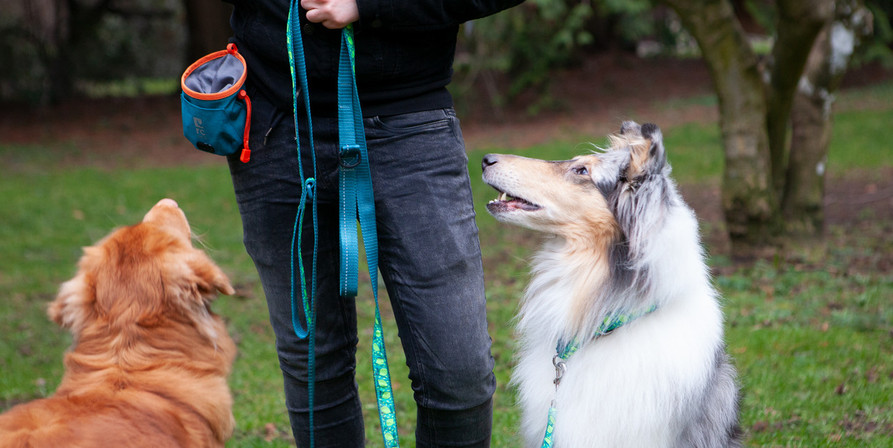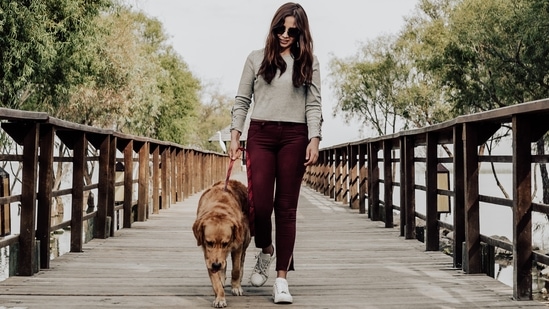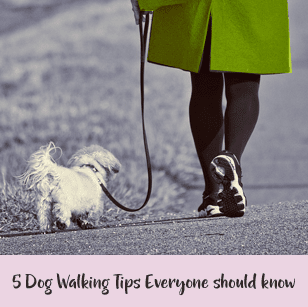To ensure a safe and enjoyable experience for both you and your furry friend, here are 5 dog walking tips that everyone should know: prioritize safety by wearing reflective clothing and equipping dogs with reflective gear, use proper equipment such as leashes and harnesses, establish a consistent walking routine, lead the way and set the pace, and reward good behavior. By following these guidelines, you can enhance your dog walking game and make the most of your time spent outdoors with your four-legged companion.

Credit: www.puppyleaks.com
1. Prioritizing Safety
When it comes to dog walking, prioritizing safety is crucial. Always wear reflective clothing, and use reflective gear on each dog, such as light-up collar clips or reflective leashes, especially when walking at night. Keeping yourself and the dogs safe should be your top priority.
When it comes to dog walking, safety should always be your top priority. Your main goal is to keep yourself and the dogs you are walking safe throughout the entire walk. Here are two important tips to help you prioritize safety:
1.1 Wear Reflective Clothing
One of the best ways to ensure your visibility during walks, especially at night or in low-light conditions, is by wearing reflective clothing. This will make you more visible to motorists and other pedestrians. Remember, safety starts with you.
1.2 Use Reflective Gear For Dogs
To further enhance safety during dog walks, make sure each dog is equipped with reflective gear. This can be in the form of a light-up collar clip or a reflective leash. These simple additions can significantly increase the visibility of the dogs, reducing the risk of accidents.

Credit: rcpets.com
2. What Not To Do
When it comes to dog walking, there are certain mistakes that you should avoid. By being aware of these common mistakes, you can ensure a safe and enjoyable experience for both you and your furry friend. Here are some common mistakes to avoid:
2.1 Common Mistakes To Avoid
- Not using proper equipment: One of the biggest mistakes dog owners make is using improper equipment for walking their dogs. It’s important to invest in a sturdy leash and a properly fitting collar or harness to ensure your dog’s safety and control during walks.
- Not creating a routine: Dogs thrive on routine, so it’s important to establish a regular walking schedule. By sticking to a routine, you can help your dog burn off excess energy and reduce behavioral issues.
- Not leading the way: During walks, it’s important for you to take the lead. By leading the way, you establish yourself as the pack leader and can guide your dog’s behavior. Avoid letting your dog pull or dictate the pace of the walk.
- Not rewarding good behavior: Positive reinforcement is key when it comes to dog training. If your dog exhibits good behavior during the walk, be sure to reward them with treats or praise. This encourages them to continue behaving well on future walks.
- Not paying attention to your dog’s needs: Every dog is unique, and it’s important to pay attention to your dog’s specific needs during walks. This includes providing them with regular water breaks, allowing them to sniff and explore their surroundings, and being mindful of their physical limitations.
By avoiding these common mistakes, you can make the most out of your dog walking adventures and ensure a positive experience for both you and your furry companion.
3. Etiquette For Dog Walking
When it comes to dog walking, it’s not just about putting on a leash and heading out the door. There is a certain etiquette that every dog walker should know and follow. This ensures a safe and pleasant experience for both you and those around you. In this section, we will discuss three important aspects of dog walking etiquette.
3.1 Holding The Leash Properly
One of the first things to consider when walking your dog is how you hold the leash. Proper leash handling not only gives you better control but also helps prevent your dog from jumping on others. When walking, make sure to hold the leash firmly but not too tight. Keep it at a length that allows your dog to walk comfortably by your side without pulling. This will prevent any unwanted accidents or disruptions during the walk.
3.2 Being Mindful Of Others
Being aware of your surroundings is crucial while dog walking. Always keep an eye out for people and animals walking nearby, especially if you are about to pass them. Give them enough space and try to predict any potential reactions from your dog. If you see someone approaching who seems uncomfortable around dogs, consider temporarily crossing the street or stepping aside to let them pass without any anxiety or inconvenience.
3.3 Respecting Property
Respecting other people’s property is another important part of dog walking etiquette. Be mindful of people’s lawns and gardens, as well as any public areas you walk through. Avoid allowing your dog to use these areas as a bathroom without permission. Always carry waste bags and clean up after your dog promptly. Remember, keeping the environment clean and neat is not only respectful but also contributes to a positive image of responsible dog ownership.
By following these etiquette guidelines, you can ensure a harmonious and enjoyable experience for both you, your dog, and those around you. Hold the leash properly, be mindful of others, and respect property, and your dog walks will become a pleasant routine.
4. Fun And Engaging Walks
Discover 5 essential dog walking tips to make your walks more fun and engaging. From prioritizing safety to exploring new routes, these tips will help you create a rewarding experience for both you and your furry friend.
Dogs love going for walks, and it’s essential to make their walks enjoyable and stimulating. Here are some tips to keep your dog’s walks fun and engaging.4.1 Letting Your Dog Sniff And Explore
One of the best ways to make a walk exciting for your furry friend is to allow them to sniff and explore their surroundings. Dogs primarily experience the world through their powerful sense of smell, so giving them the opportunity to investigate different scents can be an enriching experience for them. Let them lead the way and follow their nose as they follow interesting smells along your walking route.4.2 Changing Walking Routes For Novelty
Walking the same route every day can become monotonous for both you and your dog. To add excitement and novelty to your walks, change your routes regularly. Exploring new neighborhoods or nearby parks not only keeps things interesting for your dog but also allows them to discover new smells and sights. It’s a great way to stimulate their minds and keep their walks fresh and enjoyable.4.3 Keeping Walks Fun
While walking, it’s important to make sure the experience is fun for both you and your dog. Incorporate activities that engage your dog’s mind and body. One way to do this is by playing interactive games such as fetch or hide-and-seek during your walk. Use treats or toys as rewards to reinforce good behavior and make the walk a positive and enjoyable experience for your furry friend. Remember to always use positive reinforcement techniques and praise your dog for their good behavior. To summarize, making your dog’s walks fun and engaging is crucial for their overall well-being. Allow them to explore and sniff their surroundings, change walking routes for novelty, and incorporate interactive games to keep their minds stimulated. By following these tips, you’ll ensure that your dog’s walks are enjoyable and something they look forward to every day.5. Tips For Improving Your Dog Walking Skills
Improve your dog walking skills with these 5 essential tips! Use the right equipment, establish a routine, take the lead, reward good behavior, and keep an eye on your dog’s well-being. Walk your dog with confidence and enjoyment.
Walking your dog is not only an essential part of their daily routine but also an opportunity to strengthen your bond with them. To make the most out of your dog walking experience, it is essential to improve your dog walking skills. By using the proper equipment, establishing a routine, leading and rewarding good behavior, and paying attention to your dog’s needs, you can ensure that your dog walks are enjoyable and beneficial for both you and your furry friend.5.1 Using Proper Equipment
Using the right equipment can significantly enhance your dog walking experience. Start with a well-fitted collar or harness that distributes pressure evenly and prevents strain on your dog’s neck. Attach a sturdy leash that gives you control without causing discomfort. Consider using a waist belt or a hands-free leash, which allows for greater freedom of movement. Additionally, invest in poop bags, treats, and a water bottle to keep your dog hydrated during the walk.5.2 Establishing A Routine
Dogs thrive on routines, and establishing a consistent walking schedule can make a world of difference. Determine a specific time each day when you can dedicate quality time to your dog’s walk. Stick to this schedule as closely as possible to create a sense of predictability for your furry friend. A regular routine will not only make your dog calmer and more relaxed, but it will also ensure they get enough exercise and mental stimulation.5.3 Leading And Rewarding Good Behavior
As the dog walker, it’s crucial to take the lead during the walk. Be confident and assertive while maintaining a relaxed demeanor. Dogs respond well to calm and assertive energy. Encourage good behavior by rewarding your dog with treats, praise, or toys when they exhibit desired behavior, such as walking beside you without pulling or listening to your commands. Positive reinforcement will motivate your dog to continue displaying good behavior and improve their overall walking skills.5.4 Paying Attention To Your Dog’s Needs
Every dog is unique and has individual needs. Pay attention to signals from your dog during the walk to ensure their comfort and well-being. If your dog becomes tired, take breaks and offer water. Allow them to sniff and explore their surroundings, as this is natural and mentally stimulating for them. Be conscious of the weather and adjust the duration and intensity of the walk accordingly. Taking care of your dog’s needs during the walk will ensure a pleasant experience for both of you. In conclusion, improving your dog walking skills requires using proper equipment, establishing a routine, leading and rewarding good behavior, and paying attention to your dog’s needs. By implementing these tips, you can enhance the quality of your dog walks and strengthen the bond between you and your furry companion. Happy walking!
Credit: www.hindustantimes.com
Frequently Asked Questions On 5 Dog Walking Tips Everyone Should Know
What Every Dog Walker Should Know?
To be a successful dog walker, prioritize safety first. Wear reflective clothing and equip each dog with reflective gear when walking at night. Follow proper etiquette by keeping your dog on a tight leash, preventing them from jumping on others, and respecting people’s property.
Let your dog explore and change up walking routes for an enjoyable experience. Use proper equipment, establish a routine, lead the way, reward good behavior, and pay attention to your dog’s needs to improve your dog walking skills.
What Should You Not Do When Walking A Dog?
When walking a dog, there are certain things you should avoid doing. Do not let your dog off-leash in an unsafe area, as this can lead to accidents or their running away. Avoid using retractable leashes, as they can be difficult to control and may cause injuries.
Additionally, do not let your dog approach other dogs or people without permission, as this can lead to aggressive behavior or accidents. Lastly, do not forget to clean up after your dog and dispose of their waste properly.
How Can I Be A Better Dog Walker?
To be a better dog walker, prioritize safety by wearing reflective clothing and equipping dogs with reflective gear. Practice proper dog walking etiquette by keeping dogs leashed and preventing them from using people’s property as a bathroom. Let dogs sniff and explore, carry poop bags, and change walking routes for variety.
Use proper equipment, establish a routine, lead the way, reward good behavior, and pay attention to your furry companions.
What Is The Etiquette For Dog Walking?
Dog walking etiquette includes prioritizing safety, wearing reflective clothing, and using reflective gear for dogs when walking at night. Hold the leash tightly to prevent jumping on others and be aware of people and animals nearby. Respect people’s property and bring poop bags.
Allow your dog to sniff and explore, and vary your walking route for novelty. Reward good behavior and make the walk enjoyable for both you and your dog.
Conclusion
Safety should always be the top priority when it comes to dog walking. Make sure to wear reflective clothing and equip each dog with light-up collar clips or reflective leashes when walking at night. Being aware of proper dog walking etiquette, such as not allowing your dog to jump on others or use people’s lawns as a bathroom, is also essential.
By following these tips, you can ensure a safe and enjoyable walking experience for both you and your furry friends.







